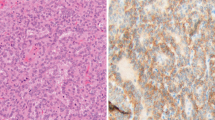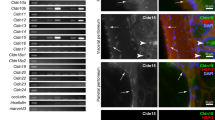Abstract
Histological diagnosis of malignant mesothelioma (MM) and differentiation from adenocarcinoma is often difficult. A number of clinical, radiologic, histologic and histochemical criteria have been used as diagnostic aids, but most cases cannot be readily classified on the basis of these characteristics. In recent years, a panel of immunohistochemical antibodies have been increasingly applied for the differential diagnosis of these two tumors. MOC-31 has been recently used as specific for adenocarcinomas while reacting with a minimal number of benign and malignant mesothelial proliferations, and HBME-1 has also been presented as a mesothelial cell marker. In this study, we aimed to show the importance of these two antibodies among the environmental MM cases from Southeastern Turkey. Fifty five cases of MM and twenty adenocarcinomas were included in this study. Histochemical (PAS, PAS-D, mucicarmine) and immunohistochemical (Keratin, EMA, CEA, MOC-31, HBME-1) stains have been performed on each case. Keratin was positive in all cases. EMA stained 50 of 55 MM and all the adenocarcinoma cases. According to our results, dPAS, mucicarmen, CEA and MOC-31 positivity was statistically significant in the diagnosis of adenocarcinoma whereas HBME-1 was demonstrable in most MM cases (52/55) and 11 adenocarcinoma cases. —This study confirmed that in the diagnostic distinction between MM and adenocarcinoma, immunohistochemistry is an important diagnostic tool, however, a panel of antibodies must be used rather than any single antibody. HBME-1 should be included in this panel; MOC-31 can be used where CEA is not available or to doublecheck the reactivity of this antibody.
Similar content being viewed by others
References
Sheibani K, Battifora H, Burke JS: Antigenic phenotype of malignant mesothelioma and pulmonary adenocarcinomas. Am J Pathol 123: 212–219, 1986
Sosolik RC, Mcgaughy VR, De Young BR: Anti-MOC-31: A potential addition to the pulmonary adenocarcinoma versus mesothelioma immunohistochemistry panel. Mod Pathol 10: 716–719, 1997
Donna A, Betta PG, Chiodera P, et al: Newly marketed tissue markers for malignant mesothelioma: Immunoreactivity of rabbit AMAD-2 antiserum, compared with monoclonal antibody HBME-1 and a review of the literature on so-called antimesothelioma antibodies. Hum Pathol 28: 929–937, 1997
Zeren EH, Gümürdülü D, Roggli VL, et al: Environmental Malignant Mesothelioma in Southern Anatolia: A study of fifty cases. Environ Health Perspect 108: 1047–1050, 2000
Warnock ML, Stoloff A, Thor A: Differentiation of adenocarcinoma of the lung from mesothelioma: periodic acid schiff, monoklonal antibodies B 72.3 and leu M1. Am J Pathol 133: 30–38, 1988
Brown RW, Clark GM, Tandon AK, et al: Multiple-marker immunohistochemical phenotypes distinguishing malignant pleural mesothelioma from pulmonary adenocarcinoma. Hum Pathol 24: 347–354, 1993
Skov BG, Lauritzen AF, Hirsch F, et al: The histopathological diagnosis of malignant mesothelioma v.pulmonary adenocarcinoma: reproducibility of the histopathological diagnosis. Histopathology 24: 553–557, 1994
Skov B, Lauritzen AF, Hirsch F, et al: Differantiation of adenocarcinoma of the lung and malignant mesothelioma: Predictive value and reproducibility of immunoreactive antibodies. Histopathology 25: 431–437, 1994
Wirth PR, Legier J, Wright GL: Immunohistochemical evaluation of seven monoclonal antibodies for differentiation of pleural mesothelioma from lung adenocarcinoma. Cancer 67: 655–662, 1991
Zeng L, Feith J, Monnet I, et al: Immunocytochemical characterization of cell lines from human malignant mesothelioma: characterization of human mesothelioma cell lines by immunocytochemistry with a panel of monoclonal antibodies. Hum Pathol 25:3: 227–234, 1994
Cagle PT, Truong LD, Roggli VL, et al: Immunohistochemical differentiation of sarcomatoid mesotheliomas from other spindle cell neoplasms. Am J Clin Pathol 92: 566–571, 1989
Sheibani K, Esteban JM, Bailey A, et al: Immunopathologic and molecular studies as an aid to the diagnosis of malignant mesothelioma. Hum Pathol 23: 107–116, 1992
Bateman AC, Al-Talib RK, Newman T: Immunohistochemical phenotype of malignant mesothelioma: predictive value of CA 125 and HBME-1 expression. Histopathology 30: 49–56, 1997
Dejmek A, Hjerpe A: Immunohistochemical reactivity in mesothelioma and adenocarcinoma: A stepwise logistic regression analysis. APMIS 102: 255–264, 1994
Battifora H, Kopinski MI: Distinction of mesothelioma from adenocarcinoma. Cancer 55: 1679–1685, 1985
Kortsik CS, Werner P, Freudenberg N, et al: Immunocytochemical characterization of malignant mesothelioma and carcinoma metastatic to the pleura: IOB3a new tumor marker. Lung 173: 79–87, 1995
Moch H, Oberholzer M, Dalquen P, et al: Diagnostic tools for differentiating between pleural mesothelioma and lung adenocarcinoma in paraffin embedded tissue. Part I: immunohistochemical findings. Virchows Arch A Pathol Anat 423: 19–27, 1993
Mezger J, Lamerz R, Permanetter W: Diagnostic significance of carcinoembryonic antigen in the differantial diagnosis of malignant mesothelioma. J Thorac Cardiovasc Surg 100: 860–866, 1990
Morgan RL, De Young BR, McGaughy VR, et al: MOC-31 aids in the differentiation between adenocarcinoma and reactive mesothelial cells. Cancer 87: 390–394, 1999
Edwards C, Oates J: OV 632 and MOC-31 in the diagnosis of mesothelioma and adenocarcinoma: an assessment of their use in formalin fixed and paraffin wax embedded material. J Clin Pathol 48: 626–630, 1995
Ordonez NG: Value of the MOC-31 monoclonal antibody in differentiating epithelial pleural mesothelioma from lung adenocarcinoma. Hum Pathol 29: 166–169, 1998
Attanoos RL, Goddard H, Gibbs AR: Mesothelioma-binding antibodies: thrombomodulin, OV 632 and HBME-1 and their use in the diagnosis of malignant mesothelioma. Histopathology 29: 209–215. 1996
Kennedy AD, King G, Kerr KM: HBME-1 and antithrombomodulin in the differential diagnosis of malignant mesothelioma of pleura. J Clin Pathol 50: 859–862, 1997
Fetsch PA, Abati A, Hijazi YM: Utility of the antibodies CA 199, HBME-1 and thrombomodulin in the diagnosis of malignant mesothelioma and adenocarcinoma in cytology. Cancer 84: 101–108, 1998
Riera JR, Astengo-Osuna C, Longmate JA, et al: The immunohistochemical diagnostic panel for epithelial mesothelioma: a reevaluation after heat induced epitope retrieval. Am J Surg Pathol 21: 1409–1419, 1997
Cury PM, Butcher DN, Fisher C, et al: Value of the mesothelium-associated antibodies thrombomodulin, cytokeratin 5/6, calretinin and CD44H in distinguishing epithelioid pleural mesothelioma from adenocarcinoma metastatic to the pleura. Mod Pathol 13: 107–112, 2000
Author information
Authors and Affiliations
Corresponding author
Rights and permissions
About this article
Cite this article
Gümürdülü, D., Zeren, E.H., Cagle, P.T. et al. Specificity of MOC-31 and HBME-1 immunohistochemistry in the differential diagnosis of adenocarcinoma and malignant mesothelioma: a study on environmental malignant mesothelioma cases from Turkish villages. Pathol. Oncol. Res. 8, 188–193 (2002). https://doi.org/10.1007/BF03032393
Received:
Accepted:
Issue Date:
DOI: https://doi.org/10.1007/BF03032393




